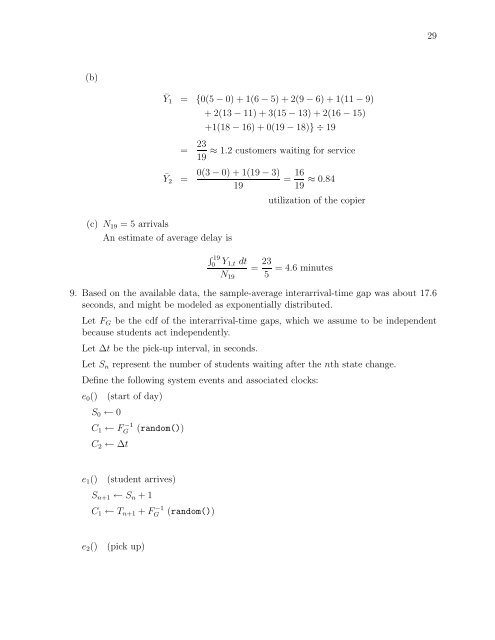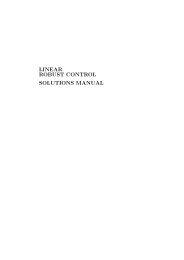SOLUTIONS MANUAL for Stochastic Modeling: Analysis and ...
SOLUTIONS MANUAL for Stochastic Modeling: Analysis and ...
SOLUTIONS MANUAL for Stochastic Modeling: Analysis and ...
Create successful ePaper yourself
Turn your PDF publications into a flip-book with our unique Google optimized e-Paper software.
29<br />
(b)<br />
Ȳ 1 = {0(5 − 0) + 1(6 − 5) + 2(9 − 6) + 1(11 − 9)<br />
+2(13− 11) + 3(15 − 13) + 2(16 − 15)<br />
+1(18 − 16) + 0(19 − 18)}÷19<br />
= 23 ≈ 1.2 customers waiting <strong>for</strong> service<br />
19<br />
Ȳ 2 =<br />
(c) N 19 = 5 arrivals<br />
An estimate of average delay is<br />
0(3 − 0) + 1(19 − 3)<br />
19<br />
= 16<br />
19 ≈ 0.84<br />
utilization of the copier<br />
∫ 19<br />
0 Y 1,t dt<br />
= 23 =4.6 minutes<br />
N 19 5<br />
9. Based on the available data, the sample-average interarrival-time gap was about 17.6<br />
seconds, <strong>and</strong> might be modeled as exponentially distributed.<br />
Let F G be the cdf of the interarrival-time gaps, which we assume to be independent<br />
because students act independently.<br />
Let ∆t be the pick-up interval, in seconds.<br />
Let S n represent the number of students waiting after the nth state change.<br />
Define the following system events <strong>and</strong> associated clocks:<br />
e 0 () (start of day)<br />
S 0 ← 0<br />
C 1 ← FG<br />
−1 (r<strong>and</strong>om())<br />
C 2 ← ∆t<br />
e 1 () (student arrives)<br />
S n+1 ← S n +1<br />
C 1 ← T n+1 + FG<br />
−1 (r<strong>and</strong>om())<br />
e 2 ()<br />
(pick up)















